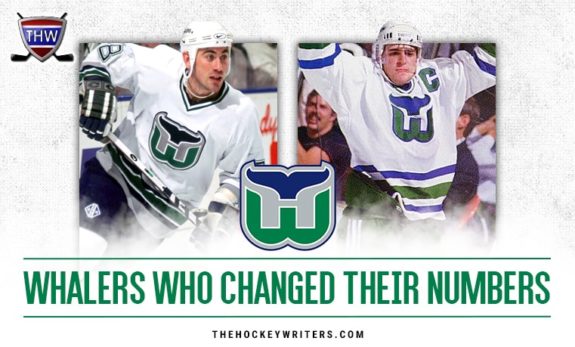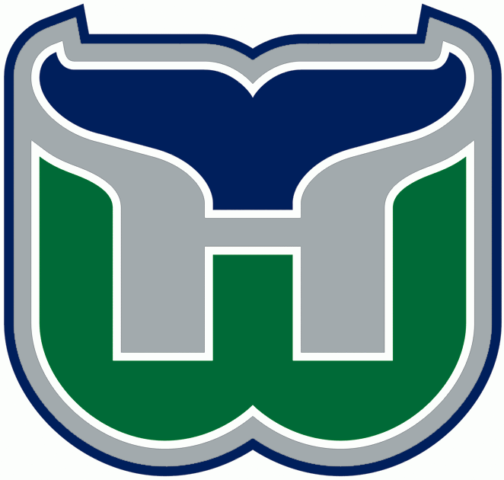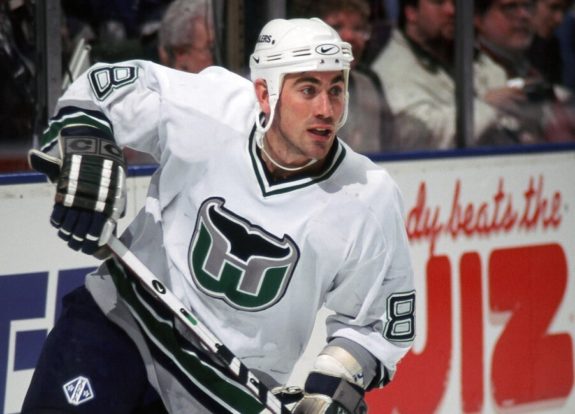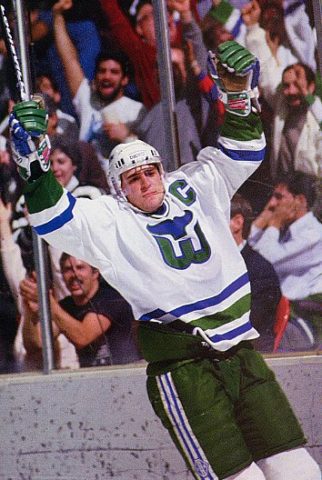The Hartford Whalers existed for 18 seasons in the National Hockey League. Between 1979-80 and 1996-97, 275 different players donned the team’s uniform and “bled Whaler green” in the process. It is a major understatement when saying that the team was deeply beloved – and still very much is – both by the city of Hartford and hockey fans abroad.
While many players suited up for only a single game as a Whaler, many more played hundreds. The most regular season games played by a single Whaler – 714 to be exact – were played by one of hockey’s most respected and admired players.

Yet among those 18 seasons and 275 individual players, there were a handful of Whalers who wore more than one number for the team. THW looks back at seven Hartford favorites who changed the number on the back of their sweater at least once.
Michael Nylander – #36 and #92 (1992-94)
Michael Nylander is a veteran of 920 NHL games and a scorer of 679 points (209 goals, 470 assists). He played for seven different teams in 15 seasons – the first of which, and the one to draft him, was the Hartford Whalers.
A native of Stockholm, Sweden, the Whalers selected Nylander with the 59th pick of the 1991 NHL draft. After playing a final season in his homeland, the centerman would come to Hartford for his rookie season of 1992-93.
In 59 games as a Whalers rookie, the teenage Nylander scored 11 goals and 22 assists for 33 points. More importantly to our take on things, he wore the number 36 during his first NHL campaign. It would be the only one of his 15 seasons that this was his number.

Struggling in the defensive-zone during his sophomore go-round, the Whalers demoted Nylander down to their AHL affiliate, the Springfield Indians. There he scored nine assists in four games during 1993-94.
Eventually returning to the parent club, Nylander switched to what would become his more familiar number 92. He would keep the same number after the Whalers traded him to the Calgary Flames on Mar. 10, 1994 as part of a six-player deal. Though he wore 92 just briefly with Hartford, Nylander would use the number with five more NHL teams during his career.
They say “like father, like son”. Nylander’s son William – a current Toronto Maple Leafs star – caused a stir when he announced on Jul. 15, 2019 that he was changing his number from 29 to 88. Perhaps there is something in genetics when it comes to jersey numbers?
Marty Howe – #18, #16 and #27 (1979-82; 1983-85)
Marty Howe is the oldest son of “Mr. Hockey” Gordie Howe. When the Whalers joined the NHL beginning with the 1979-80 season, Marty, Gordie and younger son Mark all made the jump over from the WHA.
While Marty and Mark were capable of playing offense – sometimes the three Howes even played on the same forward line together – they each found an affinity for defense after the change between leagues.
Marty had a fleeting NHL career when compared to that of his brother (16 seasons) and father (26), but still managed to play parts of six seasons between the Whalers and the Boston Bruins.
Marty played just six regular season games in 1979-80, all coming at the tail end of the season. He would, however, play in all three Whalers playoff games against the Montreal Canadiens in the opening round. He scored his first NHL goal on Apr. 9, 1980 with assists from brother Mark and Mike Rogers. Marty donned the number 18 all the while.
From there, Marty played primarily in the AHL for the next two seasons but would see call-ups in both 1980-81 and 1981-82. He would briefly switch to being number-16 during 1981-82 when he played all of 13 games in Hartford.
On Oct. 1, 1982, Marty would be traded to the Bruins. He played the fullest season of his NHL career while in Beantown – 78 regular season games – and also began wearing number 27. When he was traded back to Hartford the following autumn, Marty kept 27 as he finished out his final two seasons as a Whaler.
Scot Kleinendorst – #35 and #18 (1984-88)
At 6-foot-3 and well over 200 pounds, defenseman Scot Kleinendorst was one tough hombre. A native of Grand Rapids, Minnesota, he was an NCAA product from Providence College. The New York Rangers would draft him in the fifth round in 1980, but Kleinendorst would play the bulk of his career as a Whaler.

Bringing toughness to the roster, Kleinendorst waged some epic 1980s Adams Division battles. He went toe-to-toe against the likes of Cam Neely, Mike Hartman, Jay Miller, Basil McRae, and other divisional heavyweights. Kleinendorst racked up 452 penalty minutes through 281 regular season games, and played for the Whalers organization from 1984-85 on into 1988-89.
Though he spent some time in the AHL for the team’s affiliate in Binghamton, Kleinendorst played primarily in Hartford. Wearing 18 for most of his time as Whaler, he began his career with the team as number-35 for the 1984-85 season only.
Kelly Chase – #27 and #39 (1994-97)
Right wing Kelly Chase is so primarily remembered for his days with the St. Louis Blues alongside his fellow “Bash Brother” Tony Twist, that people often forget he played for the Whalers for two and a half seasons.
Looking to add considerable toughness, the Whalers claimed Chase on waivers on Jan. 18, 1995. Heading into the lockout shortened 1994-95 season, the pugilistic winger played in 28 of Hartford’s 48 games while wearing number 27. Chase’s number had been 39 in St. Louis, but that number was already assigned to the Whalers’ Robert Petrovicky once Chase arrived.

Chase was able to reacquire number 39 for the 1995-96 and 1996-97 Whalers seasons. However, a trade to the Toronto Maple Leafs took place on Mar. 18, 1997 where he played out the season. Chase would follow that up with a second stint in St. Louis for three more seasons after that.
In his entire 11-season NHL career, Chase wore 27 for only that first season in Hartford.
Mike Veisor – #1 and #31 (1980-83)
Goaltender Mike Veisor had worn number 1 for six straight seasons for the Chicago Blackhawks. Playing backup behind Hall-of-Famer Tony Esposito, Veisor was traded to Hartford on Jun. 19, 1980 in exchange for the Whalers’ 2nd round choice in the 1981 NHL Draft.
Once with the Whalers, he would see the most sizable amount of work in his NHL career. Veisor kept his number 1 when he arrived in Hartford, and in 29 games during the 1980-81 season he posted a record of 6-13-6.
The change to number 31 would come about the following season. Having been sent down to the AHL’s Binghamton Whalers where he would be given the new number, Veisor would be called back up to Hartford in January of 1982. Finishing out the 1981-82 season in Connecticut, he decided to keep 31. Veisor also added the “Pucky the Whale” logo above the eye holes of his mask – a trademark move that he would long be recognized for.
Veisor played 1982-83 in Hartford and the start of 1983-84 before a trade to the Winnipeg Jets on Nov. 10, 1983 in exchange for goalie Ed Staniowski. Veisor kept 31 in Winnipeg as well.
Geoff Sanderson – #13 and #8 (1991-97)
Geoff Sanderson was the last pure goal scorer to suit up in a Whalers uniform. After he was drafted 36th overall by the team in 1990, he had two 40-goal seasons in Hartford and two 30-goal seasons for the team as well. Sanderson represented the team at both the 1994 and 1997 NHL All-Star Games.
Playing the bulk of his time for the Whalers as number 8, Sanderson’s finest season came in 1992-93 when he fired away for 46 goals in 82 games. Factor in his 43 assists and 89 points, and he set career highs for all three offensive categories. Much of Sanderson’s high-scoring success in Hartford was due to being paired with superb playmaker Andrew Cassels.

While Sanderson had those 46 goals, Cassels contributed 64 assists at the same time. The tandem were brilliant together, and thrilled Whalers fans for six straight seasons.
Sanderson wearing an 8 is how he is mostly visualized for his time with the team, but he did also wear lucky number 13 for two regular season games and three playoff games during the 1990-91 season – the first five games of his NHL career.
Ron Francis – #4 and #10 (1981-91)

Ron Francis is easily the greatest Hartford Whaler of them all. He is Hartford’s all-time leader in games played (714), goals (264), assists (557) and points (821), among other team records as well. The Whalers took Francis with the fourth overall selection in the 1981 NHL Entry Draft.
He meant so much to the organization that many fans are still devastated to this day over Francis being traded to the Pittsburgh Penguins on Mar. 4, 1991 – very difficult to see the man who was the epitome of “Whaler green” raise two Stanley Cups in a black and gold uniform.
The image of Francis wearing a white number 10 on a green backdrop is forever etched into many hockey minds. So much so that many also forget that he did not always have that number.
As a Whalers rookie for the 1981-82 season, Francis scored 25 goals and 43 assists for 68 points in 59 games. He also wore the number 4 that season. Reason being? Well, Hockey Hall of Famer Dave Keon – who wore 10 during his entire 18-season career – was still playing for the Whalers at age 42.
It was not until after Keon’s retirement that number 10 would become Francis’, beginning with 1982-83 and onward.